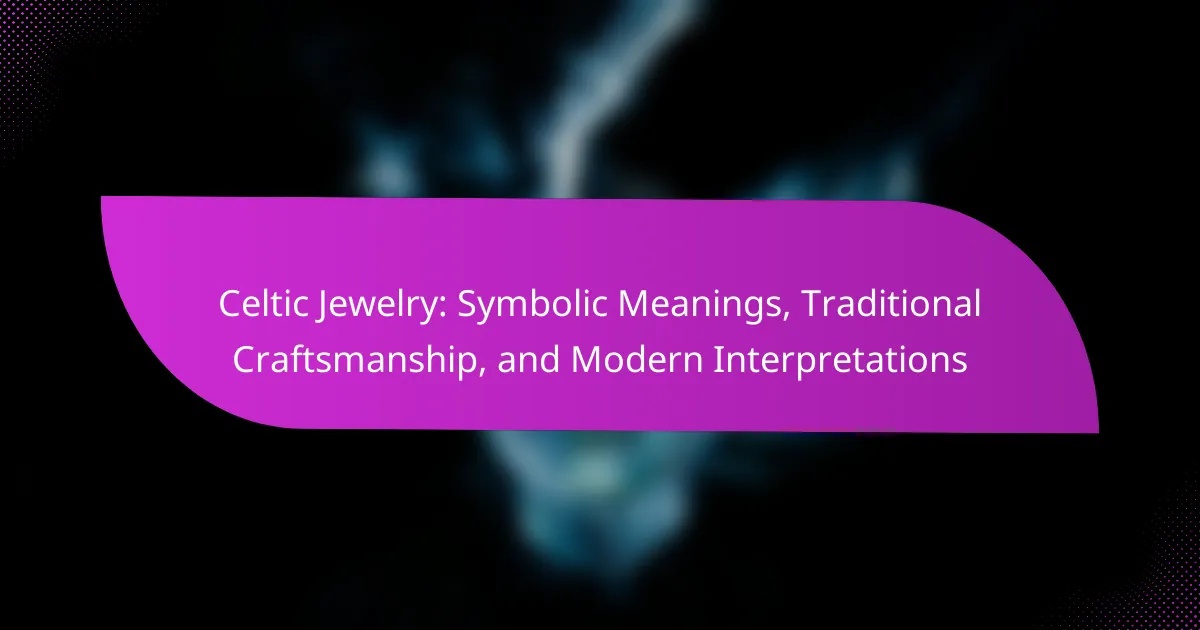Celtic jewelry is a distinctive form of adornment characterized by designs that draw inspiration from ancient Celtic art and culture. This type of jewelry often features intricate knotwork, spirals, and significant symbols such as the triskelion and the Celtic cross, which reflect deep cultural meanings related to nature and heritage. Historically crafted from metals like gold, silver, and bronze, Celtic jewelry has evolved to incorporate modern techniques while preserving traditional craftsmanship. Today, it serves not only as an aesthetic choice but also as a representation of identity and cultural significance, with an emphasis on authenticity and quality in the purchasing process. Consumers are encouraged to seek out pieces made by skilled artisans to ensure they are acquiring genuine Celtic jewelry that honors its rich historical roots.

What is Celtic Jewelry?
Celtic jewelry is a form of adornment that features designs inspired by Celtic art and culture. It often incorporates intricate knotwork, spirals, and symbols like the triskelion and the Celtic cross. These designs are rooted in ancient Celtic traditions, which emphasize connection to nature and [censured]. Historically, Celtic jewelry was crafted from metals such as gold, silver, and bronze. Today, it remains popular for its aesthetic appeal and cultural significance. Many contemporary pieces are made using traditional techniques, preserving the craftsmanship of ancient artisans. Celtic jewelry is often worn as a symbol of heritage and identity.
How is Celtic Jewelry defined within cultural contexts?
Celtic jewelry is defined as ornamental pieces that reflect the cultural heritage of the Celtic people. These pieces often incorporate intricate designs and symbols significant to Celtic history and mythology. Common motifs include knots, spirals, and animals, which represent interconnectedness and eternity. Celtic jewelry serves as a means of cultural expression and identity for individuals of Celtic descent. Historically, it was crafted using materials such as gold, silver, and gemstones, showcasing the craftsmanship of ancient artisans. Modern interpretations of Celtic jewelry continue to honor traditional designs while adapting to contemporary styles. This enduring legacy highlights the importance of Celtic jewelry in preserving cultural narratives and connections.
What are the historical origins of Celtic Jewelry?
Celtic jewelry has its historical origins in the ancient Celtic tribes of Europe, particularly during the Iron Age. The Celts, known for their intricate metalwork, created jewelry that often featured symbolic designs. These designs included knots and spirals, which represented eternity and interconnectedness. Archaeological findings, such as the La Tène culture artifacts, showcase the advanced craftsmanship of Celtic artisans. Gold, silver, and bronze were commonly used materials, reflecting the wealth and status of the wearer. Additionally, Celtic jewelry often served functional purposes, such as brooches for fastening garments. This blend of artistry and utility highlights the cultural significance of jewelry in Celtic society.
What materials are commonly used in Celtic Jewelry?
Celtic jewelry commonly uses materials such as silver, gold, and bronze. These metals are favored for their durability and aesthetic appeal. Silver is often used for its bright finish and affordability. Gold is prized for its value and traditional significance. Bronze, an alloy of copper and tin, offers a distinct, warm tone. Additionally, gemstones like emeralds, amethysts, and garnets are frequently incorporated. These stones add color and symbolism to the pieces. Natural materials such as wood and leather are also utilized in some designs. These choices reflect the craftsmanship and cultural heritage of Celtic jewelry.
What symbols are prevalent in Celtic Jewelry?
Celtic jewelry often features symbols such as the triskelion, the Celtic knot, and the spiral. The triskelion represents motion and the interconnectedness of life. The Celtic knot symbolizes eternity and the cycle of life. Spirals are associated with growth and the cosmos. These symbols have historical significance in Celtic culture, often reflecting spiritual beliefs and natural elements. They are commonly found in ancient artifacts and modern designs alike. The enduring popularity of these symbols highlights their cultural importance and aesthetic appeal.
What do the Celtic knots represent in jewelry design?
Celtic knots in jewelry design represent eternity and interconnectedness. These intricate patterns symbolize the never-ending cycle of life, love, and nature. The continuous lines of the knots illustrate the idea of unity and the interdependence of all things. Historically, Celtic knots date back to ancient Celtic culture, where they were used in various art forms. They have been found in manuscripts and stone carvings, signifying their deep-rooted significance. In modern jewelry, Celtic knots are popular for their aesthetic appeal and meaningful representation. Their designs often convey messages of loyalty and fidelity, making them popular choices for engagement and wedding rings.
How do other symbols, like the triskelion and claddagh, convey meaning?
The triskelion and claddagh convey meaning through their distinct designs and cultural significance. The triskelion, featuring three interlocking spirals, symbolizes motion and the concept of triplicity in life, such as life, death, and rebirth. Historically, it has been associated with Celtic [censured] and represents the interconnectedness of the past, present, and future.
The claddagh, depicting two hands holding a heart topped with a crown, signifies love, loyalty, and friendship. This design originated from the Claddagh village in Ireland and has been used in jewelry since the 17th century. The orientation of the heart indicates the wearer’s relationship status, making it a personal and meaningful symbol.
Both symbols are deeply rooted in Irish culture and history, which enhances their significance in Celtic jewelry. The triskelion and claddagh not only serve as decorative elements but also as carriers of rich narratives and values that resonate with individuals and communities.
What role does craftsmanship play in Celtic Jewelry?
Craftsmanship is essential in Celtic jewelry as it embodies the artistry and tradition of the culture. The intricate designs reflect historical significance and cultural narratives. Skilled artisans employ techniques passed down through generations. These methods include metalwork, stone setting, and engraving. Each piece often features symbolic motifs like knots and animals. The craftsmanship ensures durability and aesthetic appeal. High-quality materials, such as silver and gold, are commonly used. This attention to detail enhances the overall value and meaning of the jewelry.
What traditional techniques are used in creating Celtic Jewelry?
Traditional techniques used in creating Celtic jewelry include filigree, engraving, and knotwork. Filigree involves twisting fine metal threads into intricate designs. This technique adds delicate detail and enhances the aesthetic appeal. Engraving is the practice of carving designs into metal surfaces. This method allows artisans to create elaborate patterns and symbols. Knotwork features interlacing patterns that hold significant cultural meaning. These designs often symbolize eternity and interconnectedness. These techniques have been passed down through generations, preserving the artistry of Celtic craftsmanship. Historical artifacts showcase the use of these methods, affirming their authenticity and cultural significance.
How do artisans ensure the authenticity of their Celtic Jewelry?
Artisans ensure the authenticity of their Celtic jewelry through traditional craftsmanship techniques. They often use materials like sterling silver and gold, which are historically accurate. Many artisans incorporate ancient Celtic symbols and designs that reflect cultural heritage. They may source materials locally to maintain authenticity and support local economies. Documentation of the jewelry’s origin often accompanies each piece. Some artisans are members of recognized guilds, which uphold standards of authenticity. The use of traditional tools and methods is common in the crafting process. These practices help preserve the cultural significance of Celtic jewelry.

How has Celtic Jewelry evolved over time?
Celtic jewelry has evolved significantly from ancient times to the present day. Originally, it featured intricate designs and symbols reflecting Celtic culture, such as knots and spirals. These designs often had spiritual or protective meanings. In the early medieval period, metalwork became more refined, with the use of gold and silver becoming prominent. During this time, the craftsmanship incorporated animal motifs and interlacing patterns, showcasing the skills of artisans. The Renaissance saw a revival of interest in Celtic designs, leading to a blend of traditional and contemporary styles. In modern times, Celtic jewelry has expanded to include various materials and forms, appealing to a global audience. Today, it often serves as a symbol of heritage and identity, with many pieces inspired by ancient designs but crafted using modern techniques.
What influences have shaped modern Celtic Jewelry designs?
Modern Celtic jewelry designs are shaped by historical, cultural, and artistic influences. Historical influences include ancient Celtic art and symbolism, which emphasize intricate knotwork and nature motifs. The revival of Celtic culture in the 19th century spurred interest in traditional designs. Cultural influences stem from the blending of Irish, Scottish, and Welsh heritage, leading to diverse interpretations. Artistic influences arise from contemporary artists who incorporate modern techniques while honoring traditional craftsmanship. Additionally, the globalization of fashion has introduced Celtic designs to a wider audience, merging traditional aesthetics with modern styles. These factors collectively contribute to the evolution of Celtic jewelry into a contemporary art form.
How have contemporary artists reinterpreted traditional motifs?
Contemporary artists have reinterpreted traditional motifs by infusing them with modern aesthetics and techniques. They often blend ancient Celtic symbols with contemporary materials like resin and acrylic. This approach creates a dialogue between the past and the present. Artists may also simplify intricate designs for minimalistic appeal. Additionally, they explore themes of identity and cultural heritage through these motifs. Some artists incorporate technology, such as 3D printing, to innovate traditional forms. This fusion results in unique pieces that resonate with today’s audience. The reinterpretation maintains the symbolic meanings while adapting to modern sensibilities.
What trends are currently popular in the Celtic Jewelry market?
The current trends in the Celtic Jewelry market include a focus on sustainable materials and craftsmanship. Consumers are increasingly seeking ethically sourced pieces. There is a growing demand for personalized and custom designs. Many buyers prefer items that reflect individual heritage or family connections. Additionally, minimalist designs featuring traditional Celtic symbols are gaining popularity. The use of mixed metals and gemstones is also trending. Online sales have surged, driven by the convenience of e-commerce platforms. Social media influences, particularly Instagram, play a significant role in shaping these trends.
What are the cultural significances of wearing Celtic Jewelry today?
Wearing Celtic jewelry today signifies a connection to heritage and identity. It embodies cultural pride among those of Celtic descent. The intricate designs often reflect historical stories and myths. Many wearers appreciate the craftsmanship that honors traditional skills. Celtic symbols, like the knot or triskelion, represent eternity and interconnectedness. This jewelry serves as a conversation starter about Celtic culture. Additionally, it is often used in ceremonies and celebrations, reinforcing community bonds. The resurgence of interest in Celtic traditions has increased the popularity of such jewelry in modern fashion.
How does Celtic Jewelry connect individuals to their heritage?
Celtic Jewelry connects individuals to their heritage through its rich symbolism and traditional craftsmanship. Each piece often features intricate designs that represent historical narratives and cultural beliefs. For example, the Celtic knot symbolizes eternity and interconnectedness, reflecting the values of the Celtic people. Additionally, many designs incorporate specific motifs, such as the triskelion, which signifies progress and motion. These elements serve as a reminder of one’s ancestry and cultural roots. Furthermore, wearing Celtic Jewelry fosters a sense of identity and belonging among individuals. The craftsmanship often involves techniques passed down through generations, preserving artisanal skills. This connection to heritage is evident in the materials used, such as silver and gold, which have historical significance in Celtic culture. Overall, Celtic Jewelry acts as a tangible link to the past, allowing individuals to celebrate and honor their heritage.
What occasions are most suitable for gifting or wearing Celtic Jewelry?
Celtic jewelry is suitable for various occasions, including weddings, anniversaries, and birthdays. These events often celebrate love and commitment, making Celtic symbols meaningful. Celtic designs, such as the Claddagh or knots, represent unity and eternity. Additionally, Celtic jewelry is often gifted during holidays like St. Patrick’s Day, celebrating Irish heritage. Graduations also serve as an occasion for gifting, symbolizing new beginnings. Festivals and cultural events provide opportunities to wear Celtic jewelry, showcasing pride in heritage. Lastly, personal milestones, such as achievements or life changes, are ideal for wearing or gifting this jewelry.

What should consumers know about purchasing Celtic Jewelry?
Consumers should know that purchasing Celtic Jewelry involves understanding its cultural significance and craftsmanship. Celtic Jewelry often features intricate designs that symbolize heritage, [censured], and nature. Buyers should look for authentic pieces made by skilled artisans to ensure quality. Many Celtic designs, such as knots and crosses, carry deep meanings rooted in Celtic traditions. It’s important to verify the materials used, as genuine Celtic Jewelry may be crafted from silver, gold, or other precious metals. Additionally, consumers should be aware of the potential for mass-produced items that lack the traditional artistry. Researching reputable retailers can help in finding authentic Celtic Jewelry that respects its cultural origins.
How can buyers ensure they are purchasing authentic Celtic Jewelry?
Buyers can ensure they are purchasing authentic Celtic Jewelry by verifying the source and materials used. Researching reputable sellers is essential. Authentic Celtic Jewelry often features traditional designs and craftsmanship. Look for hallmarks or stamps indicating quality and origin. Genuine pieces may be made from sterling silver or gold. Check for detailed craftsmanship, as authentic items usually have intricate designs. Buyers should also seek certifications or provenance documentation when available. Engaging with knowledgeable artisans or experts can provide additional assurance of authenticity.
What certifications or marks indicate authenticity in Celtic Jewelry?
Authenticity in Celtic jewelry is indicated by several certifications and marks. The hallmark is the most recognized symbol. It confirms that the piece meets specific quality standards. In the UK, the Assay Office provides these hallmarks. They ensure the metal content is genuine, such as sterling silver or gold. Additionally, pieces may display the Celtic knot symbol. This symbol represents the craftsmanship and cultural heritage of Celtic design. Certificates of authenticity may also accompany high-value items. These documents verify the piece’s origin and craftsmanship.
What should consumers consider regarding price and quality?
Consumers should consider the balance between price and quality when purchasing Celtic jewelry. High-quality materials often result in higher prices. Authentic Celtic jewelry typically features intricate craftsmanship, which can elevate the cost. Consumers should examine the materials used, such as silver or gold, to assess value. The reputation of the maker can also indicate quality. Handmade pieces may command higher prices due to their uniqueness. Additionally, consumers should consider the longevity of the jewelry. Investing in quality can lead to pieces that last longer and retain their value.
What tips can help individuals choose the right Celtic Jewelry?
To choose the right Celtic jewelry, individuals should consider the symbolism of the designs. Celtic jewelry often features intricate patterns that represent concepts such as eternity and love. Understanding these meanings can guide choices aligned with personal values.
Next, individuals should assess the quality of the materials used. Authentic Celtic jewelry is typically crafted from precious metals like silver or gold. Checking for hallmarks can confirm the metal’s authenticity and quality.
Additionally, individuals should explore the craftsmanship involved. Handmade pieces often carry more value and uniqueness compared to mass-produced items. Researching the artist or brand can provide insights into their craftsmanship standards.
Finally, considering personal style is crucial. Celtic jewelry comes in various forms, including rings, necklaces, and bracelets. Selecting a piece that resonates with one’s aesthetic ensures satisfaction and enhances wearability.
How do personal style and preferences influence jewelry selection?
Personal style and preferences significantly influence jewelry selection by guiding choices in design, material, and symbolism. Individual tastes lead to preferences for specific styles, such as minimalist or ornate designs. These inclinations affect the selection of materials, like gold, silver, or gemstones. Personal significance attached to symbols, such as those found in Celtic jewelry, also plays a crucial role. For example, someone may choose a piece featuring a Celtic knot for its representation of eternity. This connection to personal identity and values shapes how individuals curate their jewelry collections. Studies show that consumers often select jewelry that reflects their personality and lifestyle, reinforcing their self-image. Thus, personal style and preferences are key determinants in the jewelry selection process.
What common mistakes should be avoided when buying Celtic Jewelry?
Common mistakes to avoid when buying Celtic jewelry include overlooking authenticity, ignoring craftsmanship, and neglecting symbolism. Authenticity is crucial; ensure the jewelry is made from genuine materials and not cheap imitations. Craftsmanship matters; poorly made pieces can lack the intricate detailing typical of Celtic designs. Understanding symbolism is essential; Celtic jewelry often carries specific meanings that should align with the buyer’s intentions. Additionally, failing to consider size and fit can lead to discomfort or dissatisfaction. Not researching the seller’s reputation can result in purchasing from unreliable sources. Lastly, disregarding care instructions may lead to damage over time.
Celtic jewelry is a distinctive form of adornment characterized by intricate designs inspired by Celtic art and culture, often featuring symbols such as knots, spirals, and the triskelion. This article explores the cultural significance, historical origins, and materials used in Celtic jewelry, highlighting the craftsmanship that preserves its traditional techniques. Additionally, it examines the evolution of designs, modern reinterpretations, and current market trends, emphasizing the role of Celtic jewelry in connecting individuals to their heritage and identity. Readers will gain insights into purchasing authentic pieces and the symbolism behind various motifs commonly found in this jewelry.
